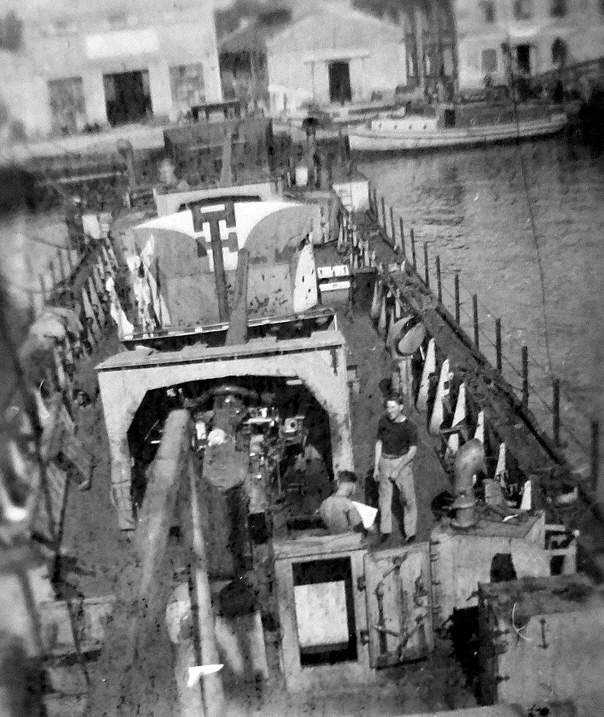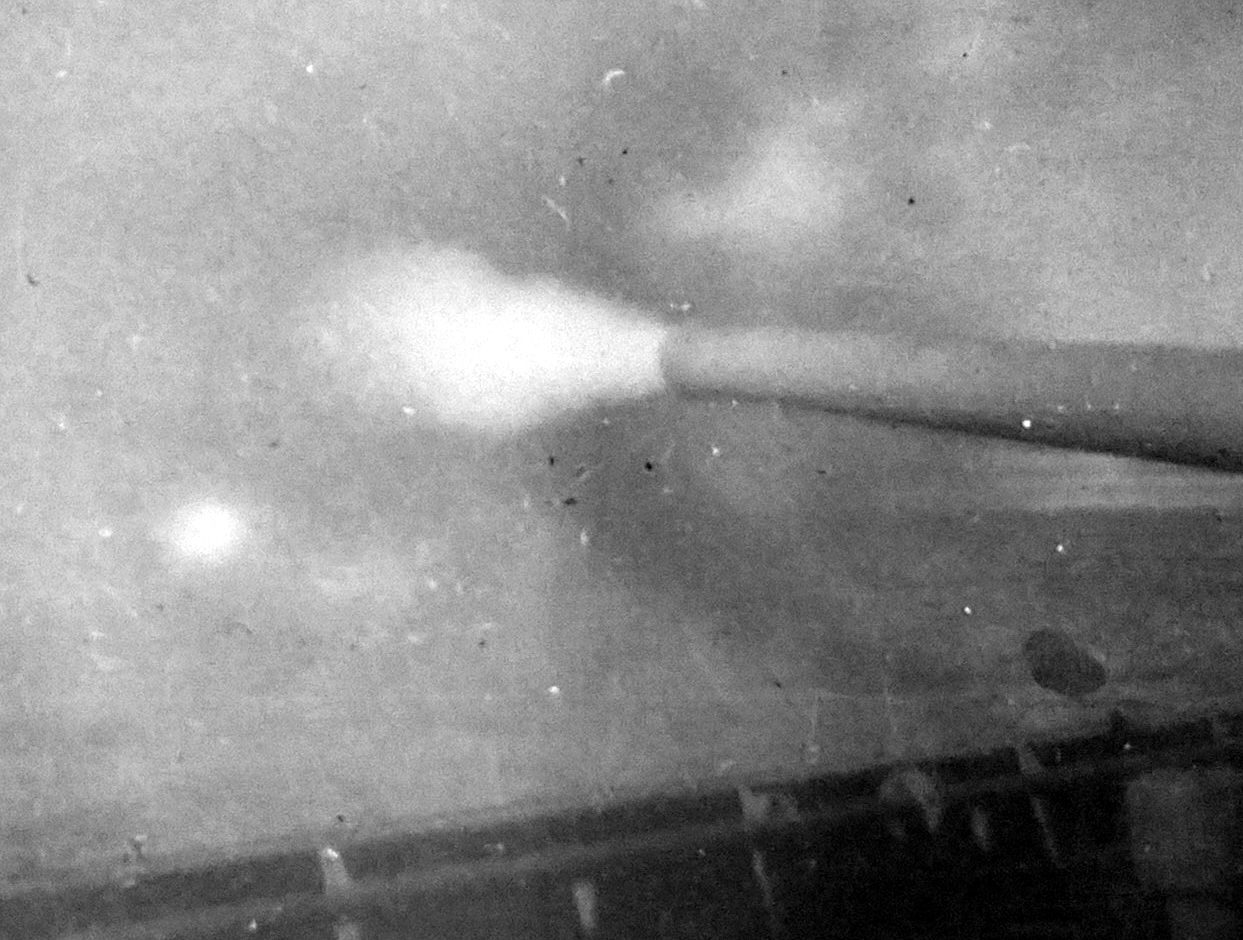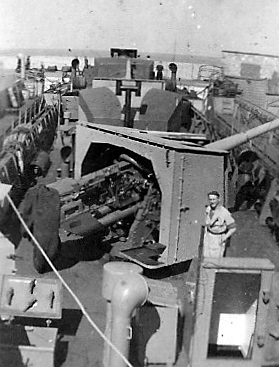- Yes, as a tech tree vehicle
- Yes, as a premium vehicle
- Yes, as an event vehicle
- Yes, as a squadron vehicle
- No, I would not like to see L.C.G.(L)(3) №19 in game.
L.C.G.(L)(3) №19 at port. Closest to the camera is her rear turret, past the pole and blast screen is the front turret, and further ahead, the 12-pounder gun pit setting her apart from her sisters.
History
The Landing Craft, Gun (Large) were two distinct classes of amphibious support vessels converted from Landing Craft, Tank (L.C.T.) vessels by the Royal Navy during the second World War. After the landings at Dieppe, it became clear that the four-inch guns of vessels such as L.C.F.(2) №1 and HMS Locust were not enough to handle heavy coastal defenses during landing operations. As such, it was decided to create a similar conversion to the Landing Craft, Flak, but designed for shore bombardment and protecting landing fleets against surface targets. The Landing Craft, Gun (Large) (Mark III) were the first twenty-three vessels born from this program, numbered 1-20 for the early series and 424, 426, and 429 for the late series.
View of 4.7" gun, with L.C.G.(L)(3) №4 visible ahead. Picture from May 1945 on the return from Yugoslavia.
L.C.G.(L)(3) №19 is one of the more storied L.C.G.(L)s, owing to the firsthand account and photographs of her crew. She was initially the same as any other member of the early series, having two 4.7" QF naval guns and two 40mm pom-poms for air defense. She was converted from an L.C.T. in 1943, and picked up her crew before making the slow journey to Gibraltar and along the African Coast. Her first bit of action was had in the Allied invasion of Sicily, and from there, she would proceed up the coast of Italy at different landing sites providing fire support for the landing infantry, including Salerno and Anzio. Owing to their large size, they were given a secondary duty of transporting supplies and commandos to and from operation sites.
Photo of L.C.G.(L)(3) №19’s Royal Marine gun crew and the ship dog.
In 1944, as part of Operation Brassard, the Allied invasion of the Italian island of Elba, №19, along with two other L.C.G.(L)(3)s, №s 4 and 20, would link up with a group of Royal Navy and American patrol vessels as part of the uncreatively named “Operation GUN”. The objective was to cut off German shipping from the west coast of Italy, which presented a unique challenge. The waters were too shallow for large ships such as destroyers to operate in, but the German defenses were too good for the coastal forces to handle, and the F-lighters were impossible to sink with their torpedoes. The solution was contracting the L.C.G.(L)(3)s. They had the perfect mix of shallow draft and big guns to destroy the targets where no one else could. So began №19’s commerce raiding duty, and she found great success in it from March to April 1944, with the help of the Royal Navy coastal boats to ward off E-boats and the American PT boats to scout out the enemy and report their positions.
Drawing from The Mosquito Fleet showing approx. location of Operation GUN.
While patrolling in Elba, №19 was struck by a mine, causing severe damage but not sinking the vessel. It was taken in for repairs, and when the crew finally rejoined the ship, they had discovered someone mounted a 12-pounder cannon on the front deck in a protective screened area with its own blast screen behind it. The reasons behind this modification are not clear, but it was the only L.C.G.(L) to have such a weapon installed. It operated in the Dalmatian Islands of Yugoslavia in 1945, providing bombardment support and transporting partisan forces to the islands. In May 1945, it finally came home after a lengthy tour of the Mediterranean. Through thick and thin, №19 had withstood the perils of landing support where many others sadly did not. The vessel was most likely scrapped after World War II was over.
Specifications
L.C.G.(L)(3) №19
Dimensions
- Length: 192 ft. 0 in. (58.5 m)
- Beam: 31 ft. 0 in. (9.45 m)
- Draught: 3 ft. 6 in. (1.07 m) for’d, 6 ft. 0 in. (1.83 m) aft
Displacement: 500 tons
Crew: 40 (17 Royal Navy, 23 Royal Marines)
Propulsion: 2 x Paxman diesel engines (1,000 shp)
Max speed: 11.5 kt (13.2 mph, 21.3 km/h)
Range: 2,200 miles
Armament
- Primary: 2 x 1 4.7" QF Mk.IX** naval guns
- Secondary: 1 x 1 12-pounder naval gun (most likely Mk.V on HA/LA mounting)
- Additional: 2 x 1 40mm pom-pom
Armor
- Bridge: 2 ½" (63.5 mm) plastic
- Wheelhouse roof: ⅜" (9.5 mm) steel
- Conning tower front: ⅜" (9.5 mm) steel
- Anchor reel plates: ⅜" (9.5 mm) steel
- Forward gun protective screen: ⅝" (15.9 mm) steel
- Gun deck sides: ⅝" (15.9 mm) steel
- Magazine sides: ⅝" (15.9 mm) steel
Additional Equipment
- Pattern 10080 rangefinder
- Pattern 3969A fire control director
Conclusion
L.C.G.(L)(3) №19 is a historic vessel with a fascinating story, helping the Allies in a little-covered front of the battles of World War II. In gameplay terms, №19 would not be too different from the standard L.C.G.(L)(3) early series. The extra bow gun would provide her some more firepower, but would restrict her firing arcs somewhat. For the standard attack profile of the L.C.G.(L) in real life, a full broadside, this would not have been an issue, but in War Thunder, it may obstruct the forward 4.7" gun detrimentally. I believe she would be an excellent addition to the British coastal forces as an event/squadron vehicle for her uniqueness as a counterpart to the standard L.C.G.(L)(3) in the tech tree.
Pictures
Sources
- https://www.combinedops.com/HM LCG 19.htm
- At Close Quarters: PT Boats in the United States Navy by R. J. Bulkley
- The Mosquito Fleet: The History of the PT Boat in World War II by Bern Keating
- C.B. 04304 (June, 1944): Details of Combined Operations Landing Craft and Barges







